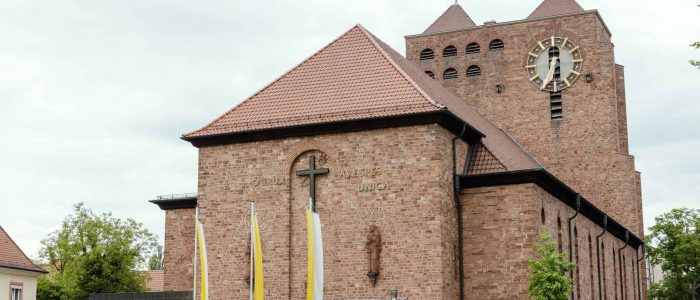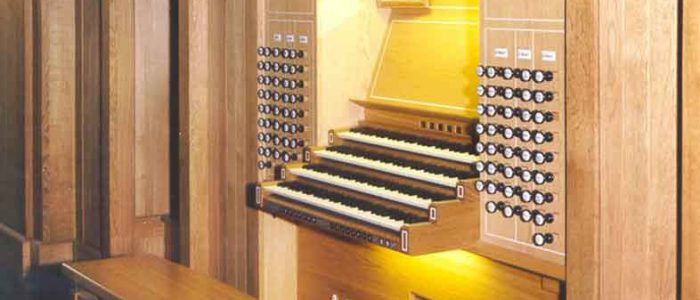Aschaffenburg, Herz-Jesu, IV/63 – Opus 300

Das bisher größte Instrument aus der Vleugels Werkstatt...
Aschaffenburg Herz-Jesu-Kirche, Orgelneubau 1995
Der Kirchenraum von Albert Boßlet aus dem Jahre 1929 war der optische Ausgangspunkt für dieses Instrument. Durch den „romanischen“ monumentalen Rundbogenstil besitzt der Raum Schwere, Massivität und Altertümlichkeit. Das atmosphärische Monument relativer Dunkelheit wirkt im Zusammenspiel mit einfachen kubischen Baukörpern und dem allgegenwärtigen Rundbogen. Hierzu wurde ein passender Prospekt „designed“. Die Aufnahme kubischer Formen und einer massiven Bauweise mit mächtigen Profilen vereinte man mit großflächigen Prospektfeldern, den auflockernden Rundbogen-Durchgängen und einem gravitätischen Pfeifenverlauf. Die Broncegußornamentik an den Pfeifenenden zeigt neben „Herz Jesu“ die Schöpfungsgeschichte, die 4 Elemente und die menschliche Arbeit mit Ihren Früchten.
The inspiration for this instrument was the church’s interior designed by Albert Bosslet in 1929. Because of the „romanic“ monumental arches the room has a heavy, massive and ancient aura. The atmosphere of relative darkness works in cooperation with simple cubic structures and ubiquitous arches. For this an appropriate organ front was designed. The integration of cubic forms and massive constructions with emphatic profiles are united in large area organ sections, the relaxed arched through-ways, and a solemn pipe arrangement. The cast bronze ornaments on the pipe ends depicts „Herz Jesu“, the story of creation, the four elements, manmade creations and the fruits of man’s labor.
Foto: Foto Alfen, Aschaffenburg

DISPOSITION
Normalkoppeln, III 4‘, III 4‘-Pedal
mechanische Spieltraktur
elektrische Registertraktur
Crescendo-Walze I u. II
elektronischer Setzer mit Sequenzern
Cymbelstern, Glockenspiel, Tympan, Vogelsang
Kegelladen für Großpedal, Gehäuse Eiche massiv

